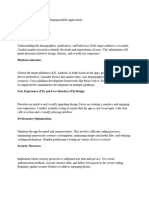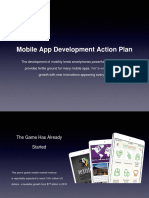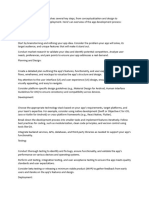0% found this document useful (0 votes)
173 views2 pagesMobile Application Notes
Mobile applications should first define their purpose and target audience. They must also plan the user experience and interface through user research and prototypes. Developers must then choose the right development approach based on their requirements, budget, and timeline, whether it be native or cross-platform development. Additionally, mobile apps need to focus on performance and optimization for responsiveness and efficiency. Finally, robust security measures are critical to protect users and their data.
Uploaded by
raju purviCopyright
© © All Rights Reserved
We take content rights seriously. If you suspect this is your content, claim it here.
Available Formats
Download as DOCX, PDF, TXT or read online on Scribd
0% found this document useful (0 votes)
173 views2 pagesMobile Application Notes
Mobile applications should first define their purpose and target audience. They must also plan the user experience and interface through user research and prototypes. Developers must then choose the right development approach based on their requirements, budget, and timeline, whether it be native or cross-platform development. Additionally, mobile apps need to focus on performance and optimization for responsiveness and efficiency. Finally, robust security measures are critical to protect users and their data.
Uploaded by
raju purviCopyright
© © All Rights Reserved
We take content rights seriously. If you suspect this is your content, claim it here.
Available Formats
Download as DOCX, PDF, TXT or read online on Scribd
/ 2


























































